Solar eclipse of February 4, 1981
| Solar eclipse of February 4, 1981 | |
|---|---|
| Type of eclipse | |
| Nature | Annular |
| Gamma | −0.4838 |
| Magnitude | 0.9937 |
| Maximum eclipse | |
| Duration | 33 s (0 min 33 s) |
| Coordinates | 44°24′S 140°48′W / 44.4°S 140.8°W |
| Max. width of band | 25 km (16 mi) |
| Times (UTC) | |
| Greatest eclipse | 22:09:24 |
| References | |
| Saros | 140 (27 of 71) |
| Catalog # (SE5000) | 9466 |
An annular solar eclipse occurred at the Moon's descending node of orbit between Wednesday, February 4 and Thursday, February 5, 1981,[1] with a magnitude of 0.9937. A solar eclipse occurs when the Moon passes between Earth and the Sun, thereby totally or partly obscuring the image of the Sun for a viewer on Earth. An annular solar eclipse occurs when the Moon's apparent diameter is smaller than the Sun's, blocking most of the Sun's light and causing the Sun to look like an annulus (ring). An annular eclipse appears as a partial eclipse over a region of the Earth thousands of kilometres wide. The Moon's apparent diameter was near the average diameter because it occurred 8.1 days after apogee (on January 27, 1981, at 20:30 UTC) and 4 days before perigee (on February 8, 1981, at 22:30 UTC).[2]
The moon's apparent diameter was 7 arcseconds smaller than the July 31, 1981 total solar eclipse.
It was visible in Australia, crossing over Tasmania and southern Stewart Island of New Zealand near sunrise on February 5 (Thursday), and ended at sunset over western South America on February 4 (Wednesday). A partial eclipse was visible for parts of Eastern Australia, Oceania, Antarctica, and western South America.
Observations
[edit]The Astronomical Society of Tasmania set up 18 observation sites on the northern and southern edges of the path of annularity in Tasmania to measure the diameter of the sun. However, data were obtained from only one site on the northern and one on the southern edge due to the clouds. The United States Naval Observatory also took images of the partial phase with portable video recorders in Tasmania.[3] Besides, due to the influence of the concave and convex peaks on the edge of the moon, if the moon is assumed to be a uniform sphere, the predicted times of each contact of the eclipse were slightly different from the actual times because the predictions assumed the moon to be a circular body but there are actually mountains and valleys on the lunar limb. The British Astronomical Association observed this eclipse in Tasmania and studied the methods to calculate the time of eclipses more accurately.[4]
Eclipse details
[edit]Shown below are two tables displaying details about this particular solar eclipse. The first table outlines times at which the moon's penumbra or umbra attains the specific parameter, and the second table describes various other parameters pertaining to this eclipse.[5]
| Event | Time (UTC) |
|---|---|
| First Penumbral External Contact | 1981 February 04 at 19:28:42.2 UTC |
| First Umbral External Contact | 1981 February 04 at 20:33:25.0 UTC |
| First Central Line | 1981 February 04 at 20:34:09.9 UTC |
| Greatest Duration | 1981 February 04 at 20:34:09.9 UTC |
| First Umbral Internal Contact | 1981 February 04 at 20:34:54.9 UTC |
| Equatorial Conjunction | 1981 February 04 at 21:58:30.2 UTC |
| Greatest Eclipse | 1981 February 04 at 22:09:23.5 UTC |
| Ecliptic Conjunction | 1981 February 04 at 22:14:36.9 UTC |
| Last Umbral Internal Contact | 1981 February 04 at 23:44:02.3 UTC |
| Last Central Line | 1981 February 04 at 23:44:44.4 UTC |
| Last Umbral External Contact | 1981 February 04 at 23:45:26.3 UTC |
| Last Penumbral External Contact | 1981 February 05 at 00:50:03.7 UTC |
| Parameter | Value |
|---|---|
| Eclipse Magnitude | 0.99375 |
| Eclipse Obscuration | 0.98754 |
| Gamma | −0.48375 |
| Sun Right Ascension | 21h13m55.8s |
| Sun Declination | -16°02'03.1" |
| Sun Semi-Diameter | 16'13.2" |
| Sun Equatorial Horizontal Parallax | 08.9" |
| Moon Right Ascension | 21h14m19.6s |
| Moon Declination | -16°29'36.7" |
| Moon Semi-Diameter | 15'53.6" |
| Moon Equatorial Horizontal Parallax | 0°58'19.6" |
| ΔT | 51.4 s |
Eclipse season
[edit]This eclipse is part of an eclipse season, a period, roughly every six months, when eclipses occur. Only two (or occasionally three) eclipse seasons occur each year, and each season lasts about 35 days and repeats just short of six months (173 days) later; thus two full eclipse seasons always occur each year. Either two or three eclipses happen each eclipse season. In the sequence below, each eclipse is separated by a fortnight.
| January 20 Ascending node (full moon) |
February 4 Descending node (new moon) |
|---|---|
 |

|
| Penumbral lunar eclipse Lunar Saros 114 |
Annular solar eclipse Solar Saros 140 |
Related eclipses
[edit]Eclipses in 1981
[edit]- A penumbral lunar eclipse on January 20.
- An annular solar eclipse on February 4.
- A partial lunar eclipse on July 17.
- A total solar eclipse on July 31.
Metonic
[edit]- Preceded by: Solar eclipse of April 18, 1977
- Followed by: Solar eclipse of November 22, 1984
Tzolkinex
[edit]- Preceded by: Solar eclipse of December 24, 1973
- Followed by: Solar eclipse of March 18, 1988
Half-Saros
[edit]- Preceded by: Lunar eclipse of January 30, 1972
- Followed by: Lunar eclipse of February 9, 1990
Tritos
[edit]- Preceded by: Solar eclipse of March 7, 1970
- Followed by: Solar eclipse of January 4, 1992
Solar Saros 140
[edit]- Preceded by: Solar eclipse of January 25, 1963
- Followed by: Solar eclipse of February 16, 1999
Inex
[edit]- Preceded by: Solar eclipse of February 25, 1952
- Followed by: Solar eclipse of January 15, 2010
Triad
[edit]- Preceded by: Solar eclipse of April 6, 1894
- Followed by: Solar eclipse of December 6, 2067
Solar eclipses of 1979–1982
[edit]This eclipse is a member of a semester series. An eclipse in a semester series of solar eclipses repeats approximately every 177 days and 4 hours (a semester) at alternating nodes of the Moon's orbit.[6]
The partial solar eclipses on June 21, 1982 and December 15, 1982 occur in the next lunar year eclipse set.
| Solar eclipse series sets from 1979 to 1982 | ||||||
|---|---|---|---|---|---|---|
| Descending node | Ascending node | |||||
| Saros | Map | Gamma | Saros | Map | Gamma | |
120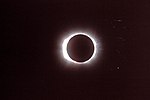 Totality in Brandon, MB, Canada |
February 26, 1979 Total |
0.8981 | 125 | August 22, 1979 Annular |
−0.9632 | |
| 130 | February 16, 1980 Total |
0.2224 | 135 | August 10, 1980 Annular |
−0.1915 | |
| 140 | February 4, 1981 Annular |
−0.4838 | 145 | July 31, 1981 Total |
0.5792 | |
| 150 | January 25, 1982 Partial |
−1.2311 | 155 | July 20, 1982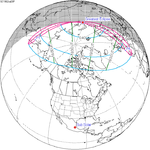 Partial |
1.2886 | |
Saros 140
[edit]This eclipse is a part of Saros series 140, repeating every 18 years, 11 days, and containing 71 events. The series started with a partial solar eclipse on April 16, 1512. It contains total eclipses from July 21, 1656 through November 9, 1836; hybrid eclipses from November 20, 1854 through December 23, 1908; and annular eclipses from January 3, 1927 through December 7, 2485. The series ends at member 71 as a partial eclipse on June 1, 2774. Its eclipses are tabulated in three columns; every third eclipse in the same column is one exeligmos apart, so they all cast shadows over approximately the same parts of the Earth.
The longest duration of totality was produced by member 11 at 4 minutes, 10 seconds on August 12, 1692, and the longest duration of annularity will be produced by member 53 at 7 minutes, 35 seconds on November 15, 2449. All eclipses in this series occur at the Moon’s descending node of orbit.[7]
| Series members 18–39 occur between 1801 and 2200: | ||
|---|---|---|
| 18 | 19 | 20 |
 October 29, 1818 |
 November 9, 1836 |
 November 20, 1854 |
| 21 | 22 | 23 |
 November 30, 1872 |
 December 12, 1890 |
 December 23, 1908 |
| 24 | 25 | 26 |
 January 3, 1927 |
 January 14, 1945 |
 January 25, 1963 |
| 27 | 28 | 29 |
 February 4, 1981 |
 February 16, 1999 |
 February 26, 2017 |
| 30 | 31 | 32 |
 March 9, 2035 |
 March 20, 2053 |
 March 31, 2071 |
| 33 | 34 | 35 |
 April 10, 2089 |
 April 23, 2107 |
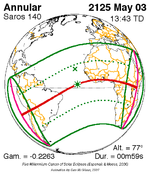 May 3, 2125 |
| 36 | 37 | 38 |
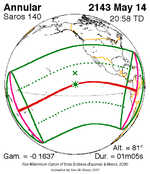 May 14, 2143 |
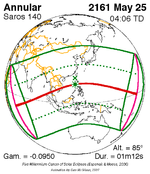 May 25, 2161 |
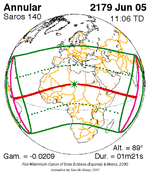 June 5, 2179 |
| 39 | ||
 June 15, 2197 | ||
Metonic series
[edit]The metonic series repeats eclipses every 19 years (6939.69 days), lasting about 5 cycles. Eclipses occur in nearly the same calendar date. In addition, the octon subseries repeats 1/5 of that or every 3.8 years (1387.94 days). All eclipses in this table occur at the Moon's descending node.
| 22 eclipse events between September 12, 1931 and July 1, 2011 | ||||
|---|---|---|---|---|
| September 11–12 | June 30–July 1 | April 17–19 | February 4–5 | November 22–23 |
| 114 | 116 | 118 | 120 | 122 |
 September 12, 1931 |
 June 30, 1935 |
 April 19, 1939 |
 February 4, 1943 |
 November 23, 1946 |
| 124 | 126 | 128 | 130 | 132 |
 September 12, 1950 |
 June 30, 1954 |
 April 19, 1958 |
 February 5, 1962 |
 November 23, 1965 |
| 134 | 136 | 138 | 140 | 142 |
 September 11, 1969 |
 June 30, 1973 |
 April 18, 1977 |
 February 4, 1981 |
 November 22, 1984 |
| 144 | 146 | 148 | 150 | 152 |
 September 11, 1988 |
 June 30, 1992 |
 April 17, 1996 |
 February 5, 2000 |
 November 23, 2003 |
| 154 | 156 | |||
 September 11, 2007 |
 July 1, 2011 | |||
Tritos series
[edit]This eclipse is a part of a tritos cycle, repeating at alternating nodes every 135 synodic months (≈ 3986.63 days, or 11 years minus 1 month). Their appearance and longitude are irregular due to a lack of synchronization with the anomalistic month (period of perigee), but groupings of 3 tritos cycles (≈ 33 years minus 3 months) come close (≈ 434.044 anomalistic months), so eclipses are similar in these groupings.
| Series members between 1801 and 2200 | ||||
|---|---|---|---|---|
 June 16, 1806 (Saros 124) |
 May 16, 1817 (Saros 125) |
 April 14, 1828 (Saros 126) |
 March 15, 1839 (Saros 127) |
 February 12, 1850 (Saros 128) |
 January 11, 1861 (Saros 129) |
 December 12, 1871 (Saros 130) |
 November 10, 1882 (Saros 131) |
 October 9, 1893 (Saros 132) |
 September 9, 1904 (Saros 133) |
 August 10, 1915 (Saros 134) |
 July 9, 1926 (Saros 135) |
 June 8, 1937 (Saros 136) |
 May 9, 1948 (Saros 137) |
 April 8, 1959 (Saros 138) |
 March 7, 1970 (Saros 139) |
 February 4, 1981 (Saros 140) |
 January 4, 1992 (Saros 141) |
 December 4, 2002 (Saros 142) |
 November 3, 2013 (Saros 143) |
 October 2, 2024 (Saros 144) |
 September 2, 2035 (Saros 145) |
 August 2, 2046 (Saros 146) |
 July 1, 2057 (Saros 147) |
 May 31, 2068 (Saros 148) |
 May 1, 2079 (Saros 149) |
 March 31, 2090 (Saros 150) |
 February 28, 2101 (Saros 151) |
 January 29, 2112 (Saros 152) |
 December 28, 2122 (Saros 153) |
 November 26, 2133 (Saros 154) |
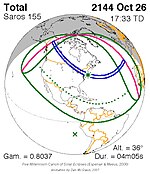 October 26, 2144 (Saros 155) |
 September 26, 2155 (Saros 156) |
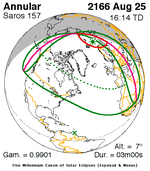 August 25, 2166 (Saros 157) |
 July 25, 2177 (Saros 158) |
 June 24, 2188 (Saros 159) |
 May 24, 2199 (Saros 160) | |||
Inex series
[edit]This eclipse is a part of the long period inex cycle, repeating at alternating nodes, every 358 synodic months (≈ 10,571.95 days, or 29 years minus 20 days). Their appearance and longitude are irregular due to a lack of synchronization with the anomalistic month (period of perigee). However, groupings of 3 inex cycles (≈ 87 years minus 2 months) comes close (≈ 1,151.02 anomalistic months), so eclipses are similar in these groupings.
| Series members between 1801 and 2200 | ||
|---|---|---|
 June 6, 1807 (Saros 134) |
 May 15, 1836 (Saros 135) |
 April 25, 1865 (Saros 136) |
 April 6, 1894 (Saros 137) |
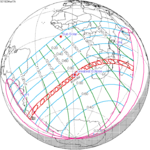 March 17, 1923 (Saros 138) |
 February 25, 1952 (Saros 139) |
 February 4, 1981 (Saros 140) |
 January 15, 2010 (Saros 141) |
 December 26, 2038 (Saros 142) |
 December 6, 2067 (Saros 143) |
 November 15, 2096 (Saros 144) |
 October 26, 2125 (Saros 145) |
 October 7, 2154 (Saros 146) |
 September 16, 2183 (Saros 147) |
|
Notes
[edit]- ^ "February 4–5, 1981 Annular Solar Eclipse". timeanddate. Retrieved 9 August 2024.
- ^ "Moon Distances for London, United Kingdom, England". timeanddate. Retrieved 9 August 2024.
- ^ Fiala, A. D., Herald, D., & Dunham, D. W. (March 1981). "Annular Solar Eclipse Observed for Solar Radius Determination". Bulletin of the American Astronomical Society. 13: 552. Archived from the original on 29 August 2019.
{{cite journal}}: CS1 maint: multiple names: authors list (link) - ^ David Herald (October 1983). "Correcting Predictions of Solar Eclipse Contact Times for the Effects of Lunar Limb Irregularities". Journal of the British Astronomical Association. 93 (6): 241–246. Archived from the original on 29 August 2019.
- ^ "Annular Solar Eclipse of 1981 Feb 04". EclipseWise.com. Retrieved 9 August 2024.
- ^ van Gent, R.H. "Solar- and Lunar-Eclipse Predictions from Antiquity to the Present". A Catalogue of Eclipse Cycles. Utrecht University. Retrieved 6 October 2018.
- ^ "NASA - Catalog of Solar Eclipses of Saros 140". eclipse.gsfc.nasa.gov.
References
[edit]- Earth visibility chart and eclipse statistics Eclipse Predictions by Fred Espenak, NASA/GSFC
- Annular Solar Eclipse Observed for Solar Radius Determination Observed from Tasmania, by Fiala, A. D., Herald, D., & Dunham, D. W, Bulletin of the American Astronomical Society, Vol. 13, p. 552
- Correcting predictions of solar eclipse contact times for the effects of lunar limb irregularities Observations from Tasmania by Herald, D. Journal of the British Astronomical Association, vol.93, no.6, p. 241–246




